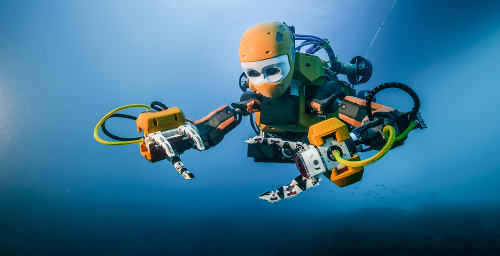Using AI to control energy for indoor agriculture
30 September 2024
Published online 19 February 2018
How a KAUST marine biologist teamed up with a Stanford robotics expert to design the world's first humanoid submarine robotic diver.

© F. Osada & T. Seguin/ DRASSM/ Stanford University
The team sent a remotely operated submersible for the long descent into the abyss and a few hours after, it spotted the first specimens. Deep-sea corals are lodged in crevices, overhangs and at the edges of faults. And while the remote vehicle could visualize them very clearly, it could not gather samples. This task is usually easy for human divers, but they cannot safely dive to such depths.
“I came back to the university both thrilled and extremely frustrated,” says Christian Voolstra, associate professor of marine biology at KAUST and the head of the 2012 deep-sea coral expedition.
Voolstra contacted Stanford robotics expert, Oussama Khatib, and his team, to help him design an underwater robot that could acquire samples The result, a few years later, was OceanOne: a five-foot humanoid robot diver with stereoscopic vision, two fully articulated arms and a tail section fitted with batteries, computers and multi-directional thrusters.
OceanOne can descend 1,000 meters propelled by a fantastic combination of artificial intelligence and robotics and haptic skills, which help it relay forces, vibrations or motions to the engineer controlling it from a boat – effectively recreating a sense of touch.
“The robot behaves as a human avatar”
Rather than build a robot only capable of performing delicate tasks underwater, Khatib designed a general robotic framework that can also be used for hazardous operations like mining and fixing underwater cables.
“Because the robot needs to be controlled at a feedback of a millisecond, you need to perceive what the robot is doing from the sensory feedback and create this loop to control the interaction of the robot with its environment.
As a result, OceanOne can function autonomously, and the engineer manning the haptic system does not need to control every single motion of coordination and dynamics. Rather, the robot behaves as a human avatar.
OceanOne took its first dip in a pool in 2015, and was able to fully swim by early 2016. Around that time, a team of marine archeologists and biologists based in Marseille, France, asked Khatib if OceanOne could dive to the seabed of the Mediterranean, 20 miles off the coast, to explore the shipwreck of La Lune, Louis XIV’s flagship vessel which sunk in 1664, and has remained intact.
The five-day mission started in Marseille in April 2016. After conducting one last set of tests at 15 meters underwater to assess the robot's performance in this environment, OceanOne went down to 91 meters where La Lune lay.
“Once it reached the seabed, the robot's motion triggered a cloud of sediments and we completely lost visibility for a few moments,” recalls Khatib.
When the image came back on, it showed OceanOne stuck between two cannons and it took some maneuvering of the haptic joystick to bring it to the surface. The robot was sent down again a few days later, and delicately picked up a Catalan vase, untouched for centuries.
Months later, OceanOne completed another mission in Greece off the coast of Santorini, exploring the Colombo underwater volcano and recovering samples.
Neither Khatib nor Voolstra are sure when OceanOne will be able to dive in the warm waters of the Red Sea to unlock the secrets behind deep-sea corals survival and adaption, the mission for which it was built. There are a string of challenges, including security fears.
doi:10.1038/nmiddleeast.2018.18
Stay connected: